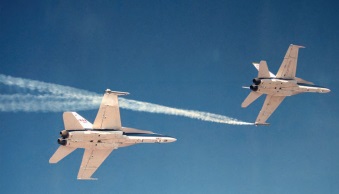Chapter: Efficient Aerospace Vehicle Technologies, new invention technology, Research project papers,
Optimized Lift for Autonomous Formation Flight (OLAFF)

Optimized Lift for
Autonomous Formation Flight (OLAFF)
Experimental in-flight
evaluations have demonstrated that the concept of formation flight can reduce
fuel consumption of trailing aircraft by 10 percent. Armstrong researchers have
developed a peak-seeking control algorithm that can increase this efficiency by
another 2 percent. The innovation works by optimizing, in real time, the lift
distribution
across the wing of an airplane flying within the wingtip vortex
of another airplane. Conventional trim schedules use anti-symmetric aileron
deflections to counter roll asymmetries and keep the wings level. In formation
flight, however, this approach can 'dump' lift near the wingtip where the
vortex effects are greatest, reducing the amount of benefit gained. The
peak-seeking solution instead uses all available control surfaces across the
span of the wing to find the best solution to maintain trimmed flight within
the vortex.
Work to date: The research team has
developed a simulation that includes probabilistic models of the
wind-drift and descent of aircraft wakes, the aerodynamic interference effects
of wingtip vortices on other aircraft, and formation guidance and control laws.
Looking ahead: The group is developing a flight experiment to demonstrate
drag reduction through cooperative trajectories using commercial, off-the-shelf
avionics systems, including Automatic Dependent Surveillance Broadcast (ADS-B)
data link technology. The experiment is expected to fly in 2015.
Benefits
Efficient: Improves
fuel savings in formation flight by an additional 2 percent
Economical: Achieves
objectives with existing control surfaces
Saves time: Allows airplanes
to fly closer together, reducing airspace congestion
Applications
Commercial
passenger and cargo aircraft Military aircraft
Drone aircraft
Efficient Aerospace Vehicle Technologies
Increasing efficiency in aerospace systems is a key goal across
the spectrum of NASA operations.
Armstrong researchers are constantly striving to build
efficiency into all phases of flight projects, through development,
fabrication, and operations processes.
From a new wing design that could exponentially increase total
aircraft efficiency to a novel test stand for single-engine electric aircraft,
our researchers are finding unique solutions that increase efficiency.
Related Topics